About ten years ago, what I call the “controller revolution” happened to the DJ world. While clubs and festivals were still dominated by turntables/DVS/CDJs, all-in-one controllers caught the DJ world by storm. Functional and affordable, controllers really tore down some barriers and made DJing much more accessible than before. At that point, most of the major players released at least one controller supporting a variety of software. Pioneer, Numark, Allen & Heath, Vestax, Stanton, NI and many more all had offerings. During that time, one question kept getting repeated: when is Rane going to release a controller?
For the longest while, the answer seemed to be “never.”
After the 2016 purchase by InMusic, Rane returned with a vengeance, putting out premium, high quality gear. While the Twelves and Seventy-Two/Seventy could technically be considered a “controller,” it is much more reminiscent of a traditional modular setup. At this point, I think most people had long stopped thinking that a Rane controller would ever be a possibility.
10 long years after the controller paradigm has become a staple of DJ scene, Rane has finally released it’s first all-in-one controller: the Rane ONE. We saw this start to leak online a few days ago, and we’re happy to see that it’s finally here.
So how does it fare?
A look at the hardware:
Let’s start by breaking down the controller.
Look and feel
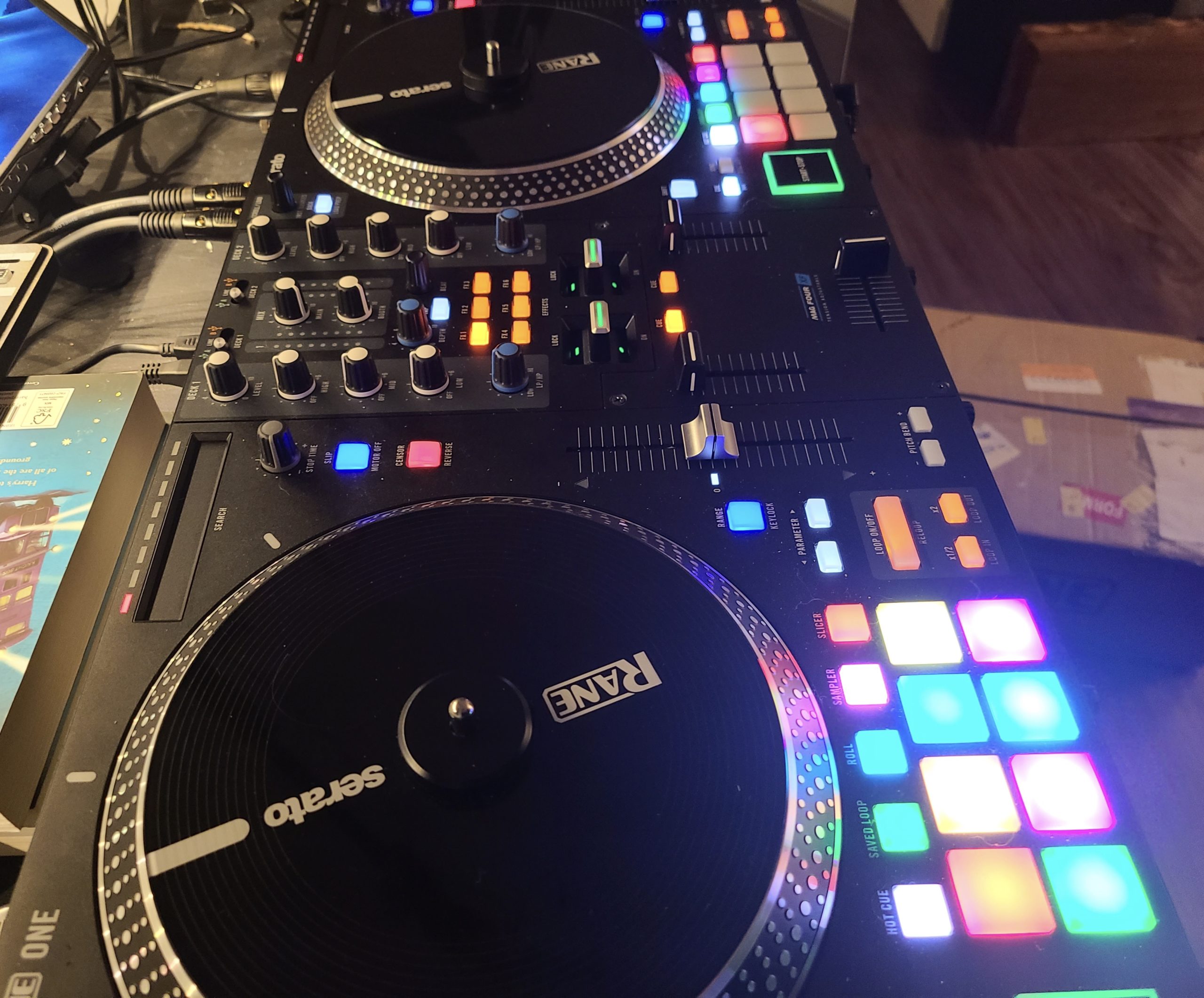
The Rane ONE is a 2 channel controller. It sports spinning, 7.2” platters, and the popular effect paddle controls, and it has a name that will spawn countless puns.
The Numark NS7 immediately comes to mind when you first see the Rane ONE. While the comparison is fair, I believe it’s mainly due to the spinning platters. The NS7 is also far more jam-packed with buttons and controls, whereas the Rane ONE is fairly simple in layout.
Aesthetically, the Rane ONE looks very boxy. The design obviously resembles a scaled-down version of Twelves and a Seventy. The entire controller rests on a set of feet – similar to what you would find on turntables. Everything on the controller looks and feels like it comes straight from its bigger siblings. It has the same solid steel housing, burnished metal plates, knobs, pads, and buttons, effect paddles, platter design (albeit smaller), plunger-style Start/Stop buttons, and – of course – the same Mag Four fader.
Layout
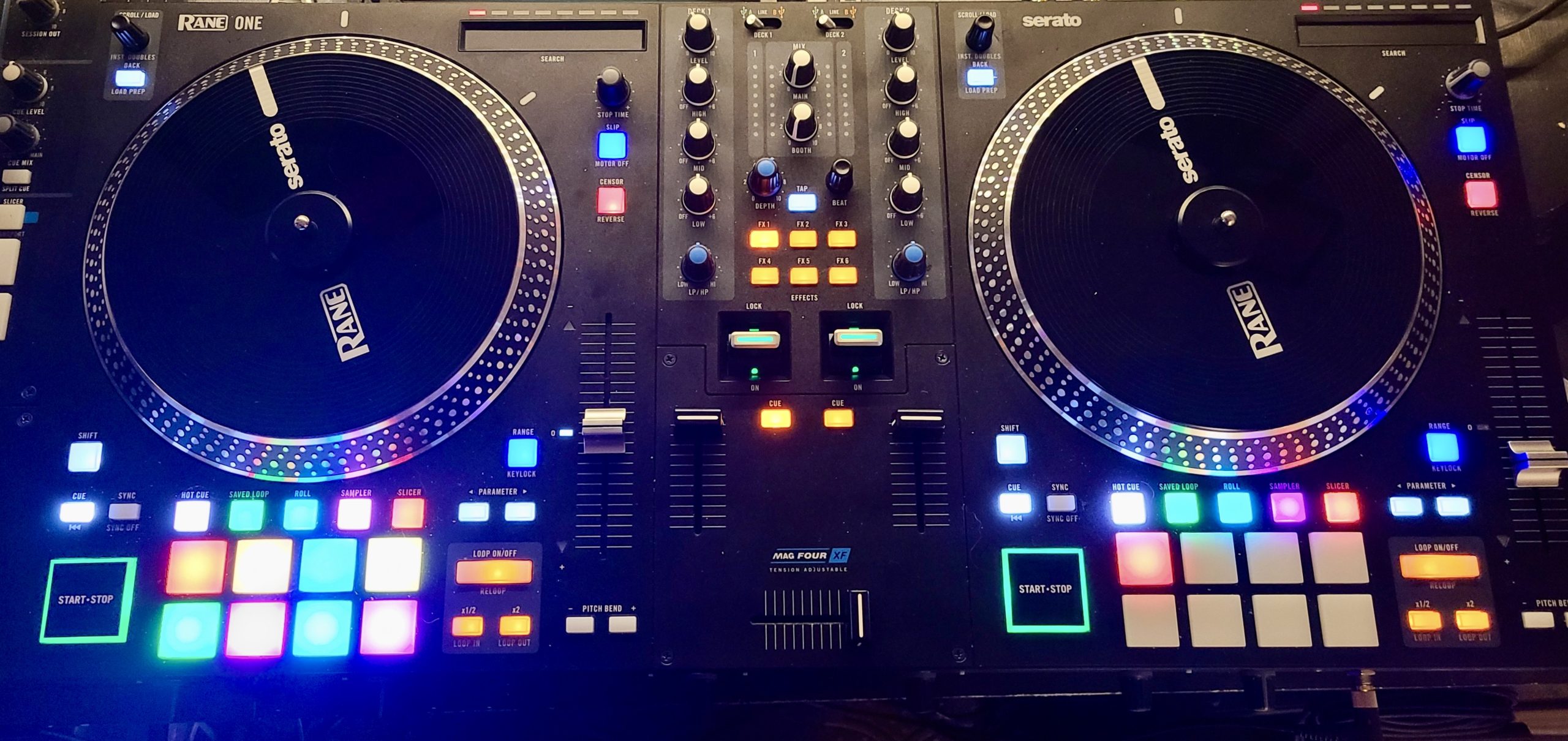
From a layout perspective, there are few surprises. It follows the standard asymmetrical design that seems to be the norm now. The standard 8-pad-per-side setup resides below the platters with various buttons for standard features. There are also some additional controls that are less common – pitch bend buttons, censor and slip buttons, and a pitch range button that doubles as a key lock. The 100mm pitch faders are the same as those found on the Twelves, and the Denon players. They tend to be a little lighter and smoother with just a bit of resistance.
A touch strip resides above the platters, albeit a fair bit shorter than most controllers.
Mixer
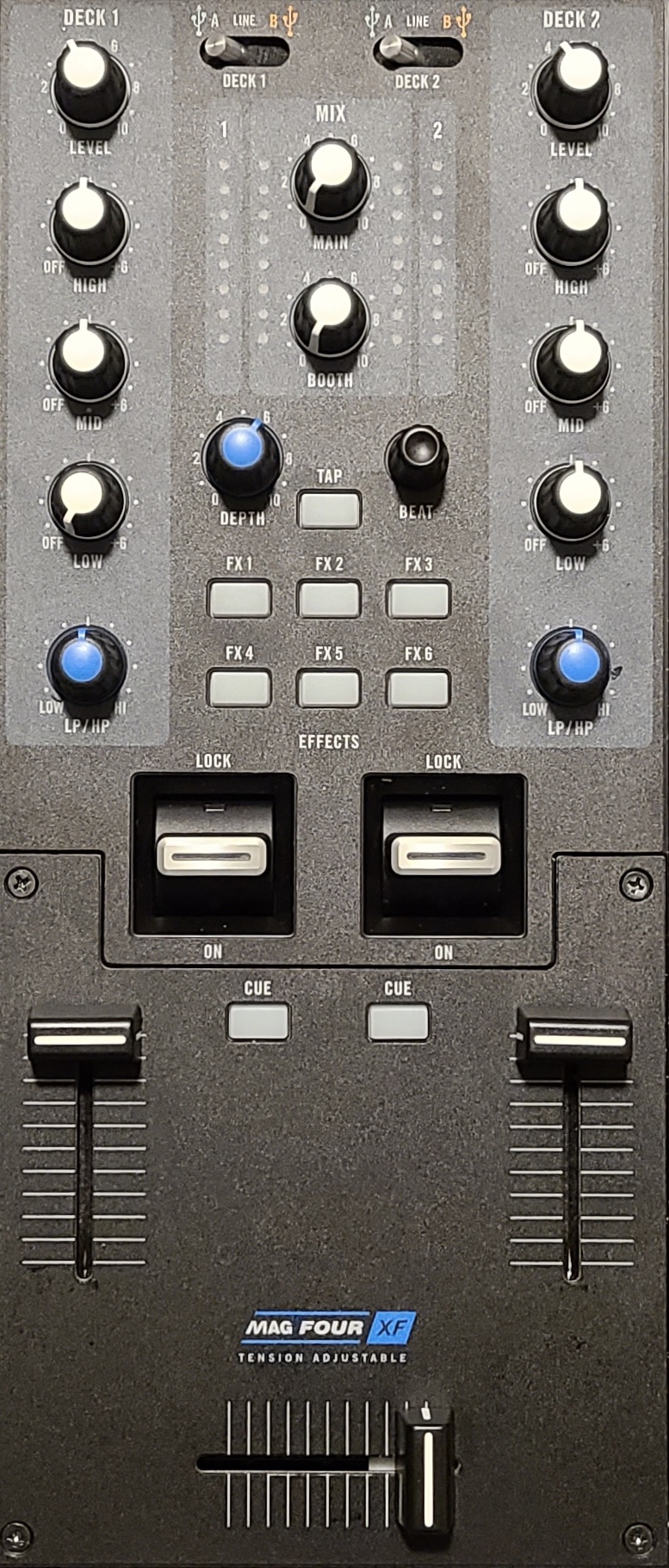
The mixer section is fairly straightforward, with a pair of knob strips that contain your standard gains, EQs, and filter. In between the EQs are a pair of knobs for the independent Main and Booth volumes, and the effects section with the now-standard effect paddles directly below.
All in all, it’s a fairly standard controller layout. The ONE keeps in line with the grand majority of controllers on the market and is fairly easy to dive into. While pretty streamlined, I do find the area with the auto loop controls a little cluttered. There are 3 sets of dual buttons that control different functions and it’s easy to hit the wrong ones if you aren’t paying attention.
Build Quality
This is the most sturdy controller I have ever used – period. The all-metal build with the burnished plates and steel chassis exudes quality. It feels incredibly solid and well put together. In short: it feels like a Rane.
If your only experience has been plastic controllers, mixers, and CDJs, it is difficult to describe just how weighty and solid it feels. Some prefer to minimize weight when it comes to gear, but not me – I like that solid, meaty, hefty feeling for my money. Who wouldn’t I want the feeling that their gear could potentially survive a nuclear blast? Sure, I understand most of this is psychological – plenty of lighter, plastic gear has stood the test of time. For me, it’s a reassuring quality and something I always prefer in my gear.
Sound Quality
Rane has earned their reputation for superior sound quality many times over, and the ONE maintains the level of quality expected from the company. The DA converters are different from the Seventy mixers, which is somewhat expected given the price point – but the familiar warm and rich sound profile is absolutely present.
Unlike the Rane mixers, the Rane ONE utilizes software-based mixing. This means the EQs, filters, and summing are all done within Serato rather than in the hardware. While it’s not super obvious, it doesn’t quite measure up to the sound of the Rane Seventy-Two that I have (which is to be expected). In fact, when using the controller as a pure audio mixer (which switches to hardware EQs, filters, and summing), I notice a subtle improvement. That said, the grand majority of people will not notice this at all.
In terms of controllers, though, the Rane ONE is coming for Roland’s crown as the best sound controller on the market.
Phono preamps
The phono preamps are typical Rane – meaning they sound fantastic. If it’s one thing Rane does not cut corners on, it’s their phono preamps. That typical rich, beefy sound from their preamps is fully present on the Rane ONE.
Platters
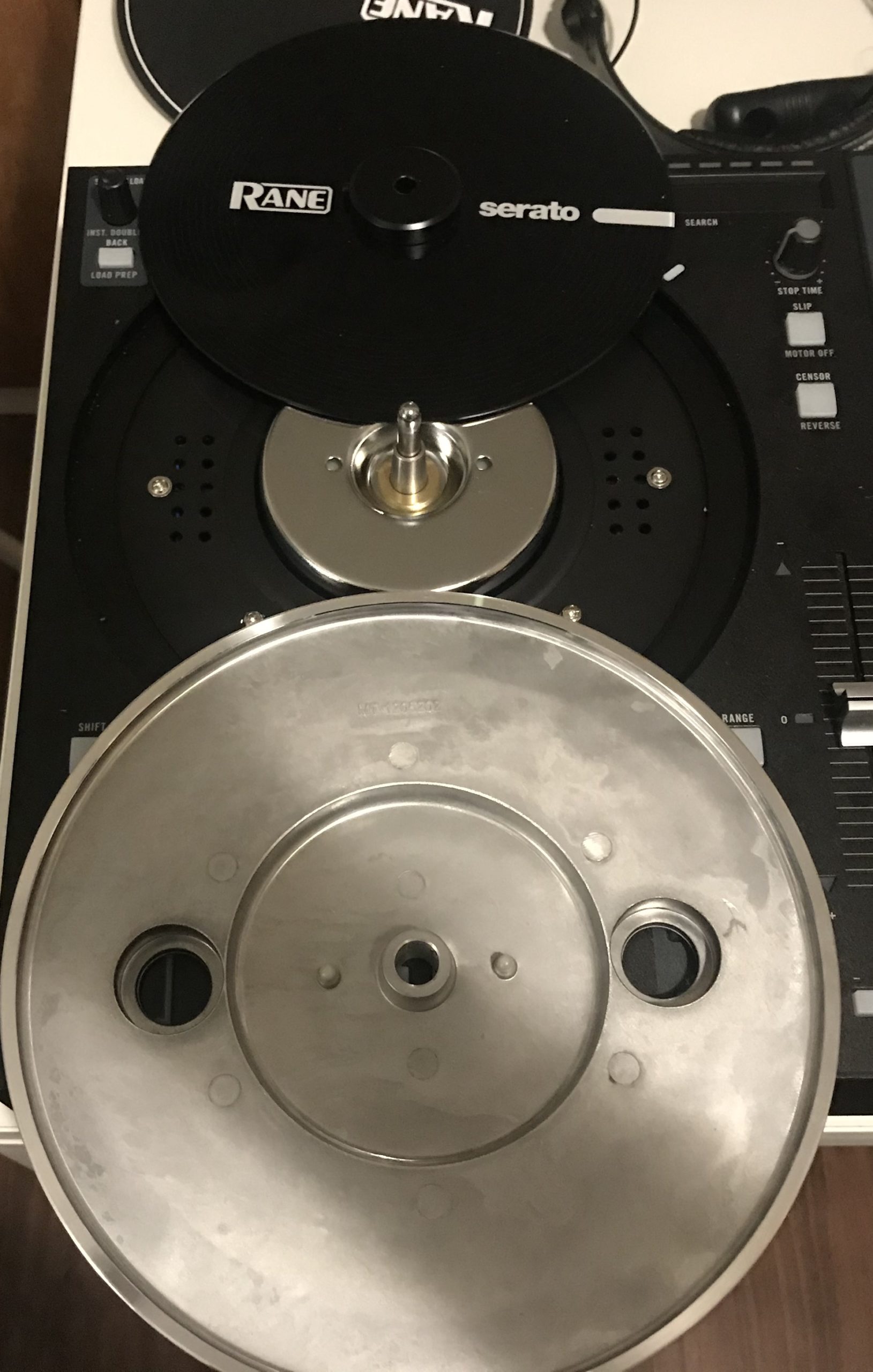
The platters are the most eye-catching part of the controller. At a glance, they seem like 7” platters, but are actually a little larger at 7.2” in diameter. Although it doesn’t sound like it, that extra quarter inch does makes a difference in terms of feel.
At the centre, the quick-release adaptors lock the plates to the rotating spindles used to translate the platter movement to Serato. The large adapter gets in the way of the smaller plates found on the NS7 or SC5000M, so that extra space gives you a bit more room to work with.

The acrylic plates are the same style as the Rane Twelves, which is somewhat divisive to DJs. One complaint often tied to the Rane Twelve acrylic plates is its weight. This smaller size reduces the plates’ weight considerably, which makes it easier to cut on.
I even went as far as to try out the plates on the Twelves. Many DJs opt to swap out the plates for real vinyl there, but due to the non-standard size of the platters on the ONE, while possible, you will lose out on platter real estate by using custom 7” records.
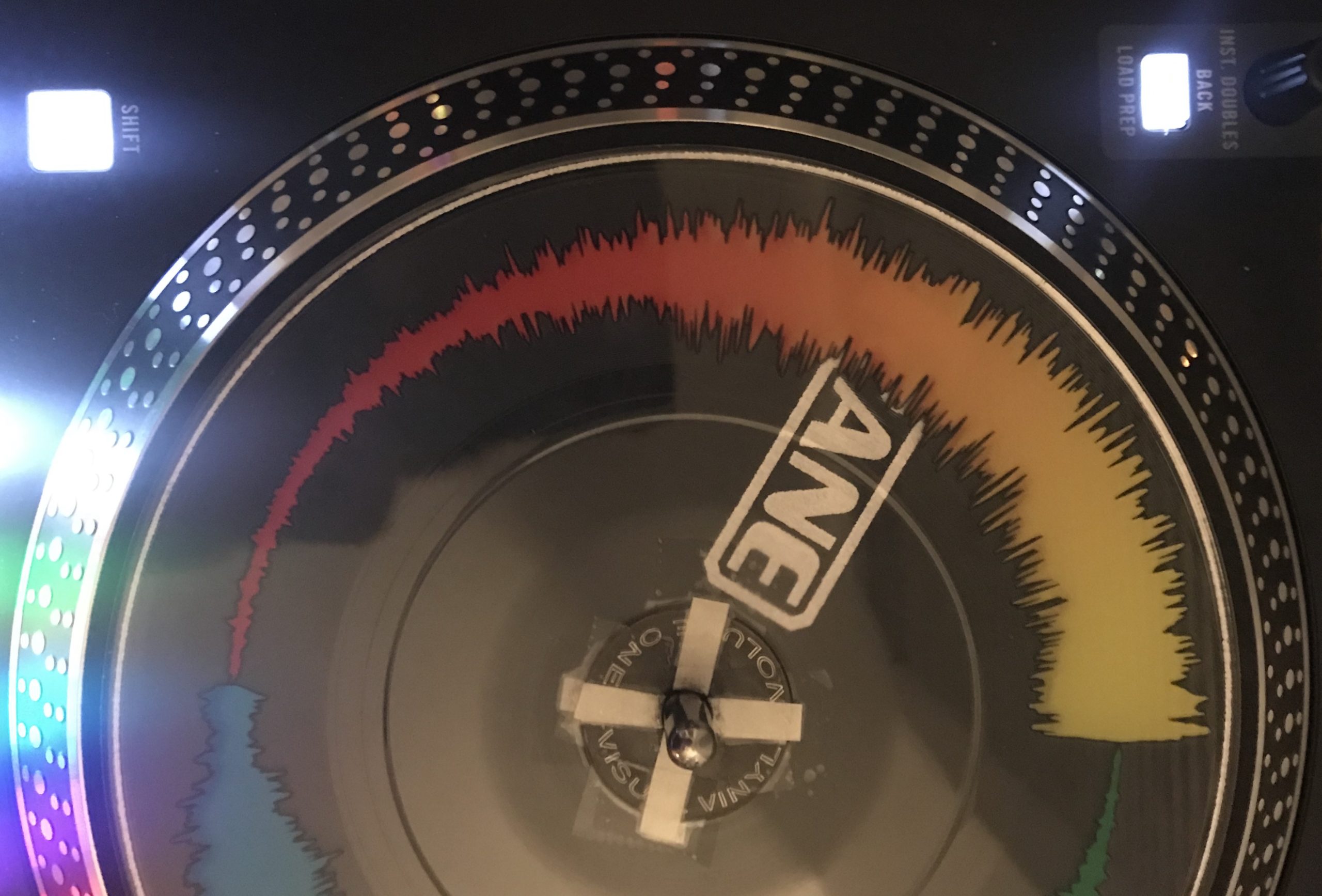
Feel-wise, they are great – responsive, tactile, and just all around fun to play on. They probably use the same motor as the Twelves and SC5000/6000Ms. You can adjust the torque between high and low, much like the Twelves. It’s likely there’s less torque on the motor to compensate for the smaller platter, but it feels snappy and starts instantly in high torque mode.
Pads & Buttons
The pads feel exactly like those on the Seventy or Seventy-Two, meaning they are lifted from the legendary Akai MPC line of samplers. The functionality of the pads is good but not great. It’s not loaded to the gills with features or anything, but it’s got everything you’d probably need. The pads contains 5 pages, each with 1-2 options: Hot Cues, Pitch Play, Saved and Auto Loops, Loop rolls, Sampler, Slicer (regular and looped), and Serato’s brand new Scratch Bank.
The remaining buttons are the hard, clicky buttons that feel identical to the ones on the Rane mixers. In the past, Rane has traditionally struggled with these buttons wearing out faster than they should. But nearly 3 years in and my Seventy-Two buttons still work fine, so it looks like they finally overcame that hurdle.
Effects
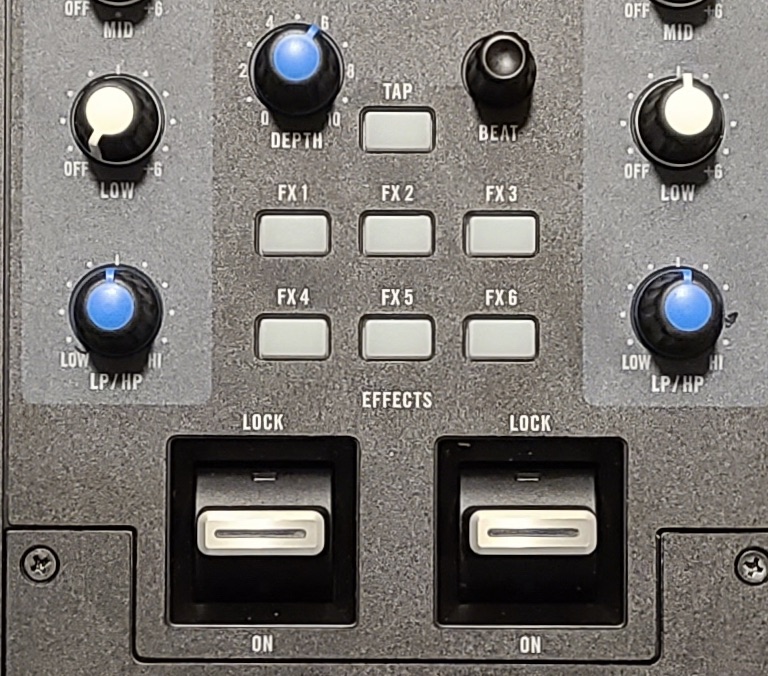
So it looks like InMusic is going all-in with the effect paddles for a number of their products. The paddles use the same die-cast metal paddles found on the Rane mixers and feel identical to the ones on the mixer. The effects section is 100% software. In that respect, it resembles the newer Numark gear like the Scratch or Mixtrack ProFX. Unlike the Numark gear, there aren’t default effect settings and it’s up to the user to set whatever they want. In addition, there are a pair of knobs – one to control the depths of all 6 effects at once, and the other to control the timing of the effect, and a tap tempo button.
Crossfader

The Rane ONE sports a Mag Four crossfader, the same as those found in their mixers. While I place it a close third – behind the Pioneer Magvel Pro and the Innofader – on the list of my favourite crossfaders, it’s still a fantastic fader to cut on. I don’t think a single controller has a fader this high-quality installed stock. The higher-end Pioneer controllers have Magvel crossfaders, not the premium Pro faders – and they aren’t quite the same quality. With the ONE, you get the same fader you would on their $1,500USD+ mixers.
That said, because the crossfader curve and cut lag is all controlled within the software, it’s just not quite the same tight and organic feel of the Mag Four on the Seventy or Seventy-Two MK2. Not sure if it’s the curve or the digital nature, but it just feels a little “off” to me. Of course, this is to be expected since the Seventy alone costs the same as the ONE.
Upfaders
The upfaders are unfortunately not Mag Four faders – which I believe is a first for a Rane device. As far as I can tell, they are standard VCA faders and not non-contact like the Mag Four. Typical to a lot of other companies, these faders also have a great deal more resistance to them. Some people prefer this, but those that like using upfader techniques to scratch might be a little irked at this decision.

All the faders have curve adjusts and are reversible. Unlike their mixers, the fader knobs control the Serato software rather than being hardware.
Cut in feature

Browsing the Mixer tab in the Serato Settings also reveals another brand new feature – a software Cut In adjust for the crossfader. This allows you to customize the cut “lag” – meaning the distance between on and off on your crossfader. This is a very welcome addition to Serato DJ Pro and hopefully will make its way to other gear that utilizes Serato’s internal fader settings (like the Numark Scratch).
Pots
The pots are the same pots as those on the Rane mixers. This means plastic stems, and a little looser feeling than I usually care for. The components are better than the old Sixty series mixers’ pots (which got very loose after a year or two), but I still prefer the metal stems found on other gear. I also prefer little more resistance. The grippy knobs feel nice enough, though, and the performance is great and very easy to get precise movements on your knob twiddling. I still usually swap those out for Chroma Caps though.
Inputs and Outputs

Rane never skimps on their I/O and the ONE is no exception. In a bit of a departure from their usual options, Rane opted to reduce the outputs to 2 volume controls rather than the usual 3. The Main outs offer both XLR and RCA controlled by the same knob. In another departure, instead of the traditional 1/4” Booth outputs, they decided to use a 2nd set of XLR outs instead, much like the Denon Prime 4. The headphone outputs include both 1/4” and 1/8” plugs and includes the standard Cue/Mix knob as well as a Split Cue switch.
In terms of inputs, there are a pair of RCA inputs that are both switchable between line and phono. A third RCA aux input is controlled by the Mic 2 controls, switchable between the Aux and Mic inputs.
And of course, the dual USB ports for seamless laptop switching is almost standard in a controller this price point these days.
Like most high-end controllers, the Rane ONE can be used as a full mixer for additional gear like turntables or CDJs. It also supports DVS when purchasing the Serato DVS plugin. That said, I’m not sure how many DJs would care to use DVS when the excellent spinning platters are right there.
Microphones

The Rane ONE offers two microphone combo jack inputs. They are controlled by a set of knobs on the front of the controller and includes a 2-band EQ along with the volume knob. As mentioned, the Mic2 controls can flip to controlling the volume of the Aux input.
Size and Weight
The solid steel chassis definitely has some heft to it, but at 23.5 lbs, it is a full 10 lbs lighter than the Numark NS7 and even 5 lbs lighter that the Pioneer XDJ-XZ. This is about the weight of a Technics 1200 and a little more manageable than the its Numark counterpart. In a case I would expect the unit to weigh around 50 lbs – which, while not light, isn’t terrible.
Size-wise, the dimensions are 26.5” x 13.6” x 4.9”. It’s not small, but it’s also not massive like some of the larger controllers out there. It’s roughly the same size as the DDJ-SX3 or slightly smaller than the DDJ-1000.
Here’s what we liked:
So, what’s so great about the Rane ONE? Our favorite elements:
Feet
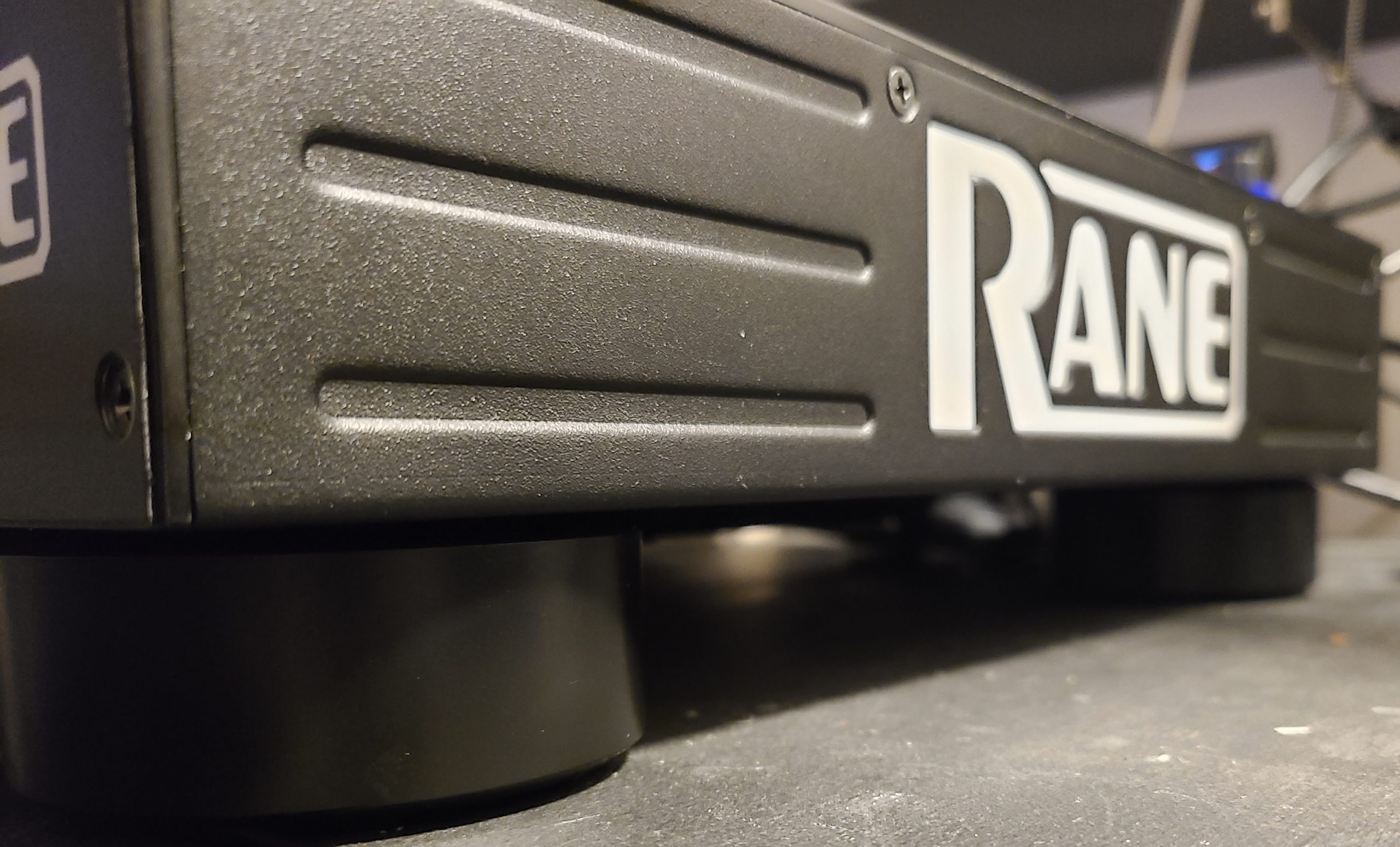
The Rane ONE has the same type of feet found on turntables and the Twelves. They effectively raise the height to a level more consistent with club mixers, turntables, and CDJs. Being able to tuck cables and laptop stands under the unit is an added bonus to this controller. I can’t believe something so simple hasn’t been more widely used in the controller world.
Platters
Just like Rane is becoming the spinning platter division of InMusic, I feel like I’ve become the “spinning platter guy” at Techtools. That’s a title I’m willing to own, honestly. I love spinning platters and the platters on the ONE are just great. The extra size to the platters makes more of a difference than I expected. Initially, I was hoping for something larger like a 10″ platter, but I feel pretty satisfied with the 7 1/4” platters.
Crossfader
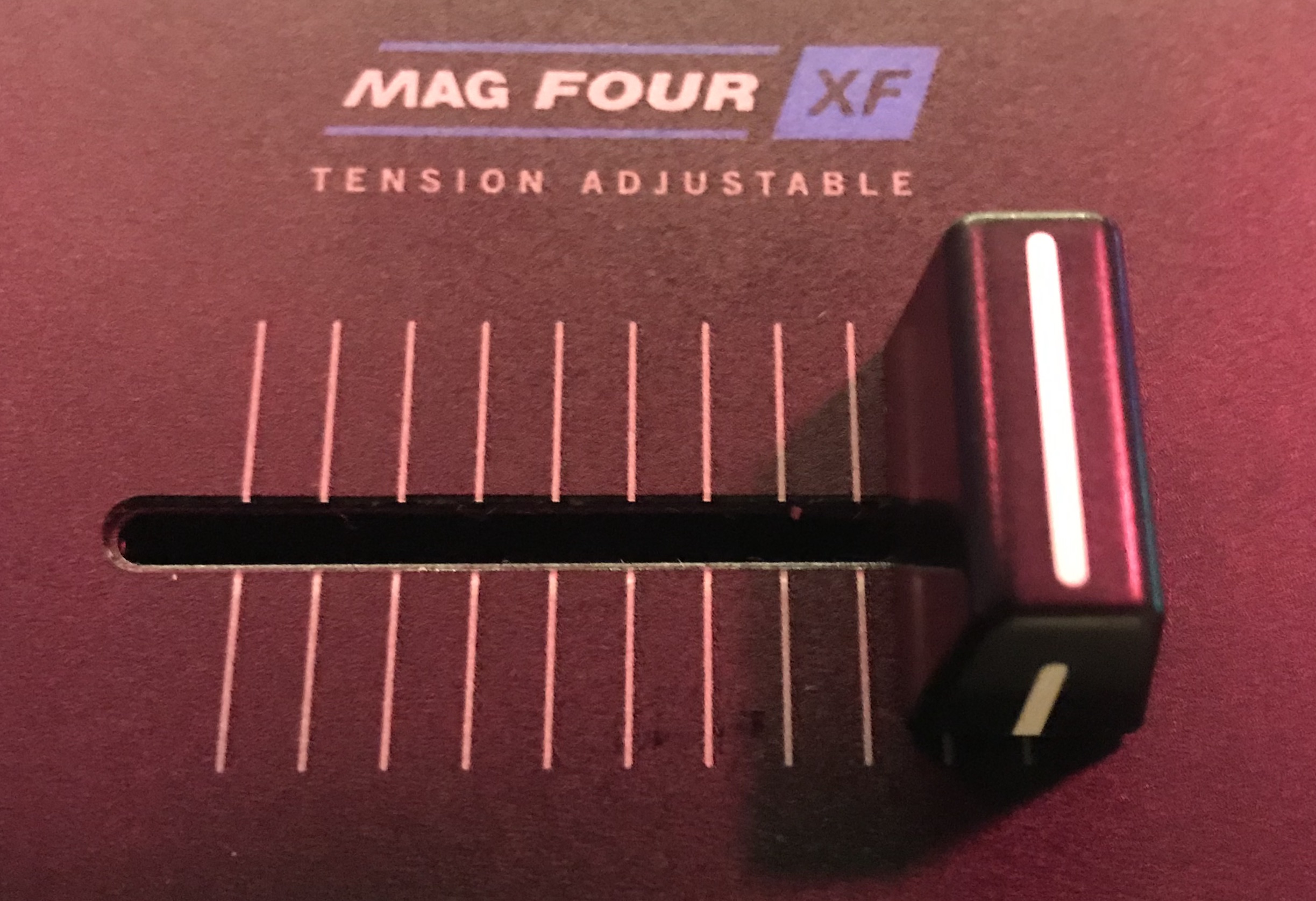
The Mag Four is the best crossfader found on any controller right now. It may not be my favourite (that would be the Innofader), but it’s pretty close. Just another reminder of the high quality of this controller.
Start/Stop plungers
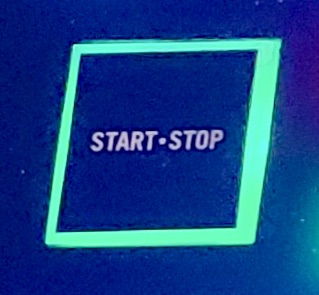
I love these. There’s nothing inherently superior about turntable-style plunger buttons other than it makes me happy using them. It’s just another reminder that I’m on a controller that’s captures the essence of the old school turntable aesthetic.
Scratch Bank
I’m glad this feature is becoming more the norm because it’s honestly awesome. It’s also a feature that fits perfectly with target market of the Rane ONE.
Build
If there was a controller that encapsulates the term “built like a tank,” it would be the Rane ONE. Just a solid piece of gear that feels as professional as it can get.
Sound
It’s the Rane sound in a controller. It’s not quite on the level of the Rane mixers, but it’s easily one of the best sounding controllers I have ever heard.
Mic Controls
The 2-band EQ is a welcome addition compared to the tone knobs on the Seventy and Seventy-Two. You get much better control and are able to compensate for feedback issues way easier using EQs.
Class Compliant sound card
In 2020, there’s really no excuse to not have a class compliant sound card. Every year Apple updates their OS, and every year something gets broken. Drivers take month to update, software is no longer compatible, and older gear gets left by the wayside. Class compliancy helps alleviate some of the issues, and leads to faster compatibility.
Cost effectiveness
$1,500USD is not cheap, don’t get me wrong. But compared to the $3,000+ cost of a pair of Twelves and a Rane mixer, it’s a pretty decent deal.
Things we’d like to see improved:
While those are some of our favourite things in the Rane ONE, there are a couple of things that bother us about the controller.
Lack of custom MIDI pages
I was disappointed that there are no custom MIDI pages on the Rane ONE. I regularly map out a set of controls for my gear and I found myself missing them. While most of the default controls can be remapped, the lack of page mapping makes it less flexible. Even one or two custom mapped pages would have been nice.
Noise
The Rane ONE has a built-in fan, which isn’t the most common thing in controller – and it’s very noticeable. I’m not sure what is causing all the heat that requires a fan, but I noticed it kicks in when the platters are spinning. In contrast, the Rane Twelves are whisper quiet, so it’s a little jarring to hear such a noisy controller.
Effects

Serato effects are really not my favourite. They lack a certain amount of character and functionality compared to dedicated hardware effects. On top of that, the software effects don’t set optimal timing depending on the effect. For instance, I would want the Echo effect to have shorter timing – like 1/2 or 1 beat. For something like a flanger, though, I would want a much longer beat time. Ideally, the timing would be bound to the effect itself. On Serato this simply isn’t possible, so I need to manually change the timing each time I use a new effect.
I understand that hardware effects would likely drive the price up a great deal, so it’s not realistic – but I’d like to see some improvements from Serato’s end. The Serato effects have been pretty stagnant for years and maybe it’s time to revisit them, especially considering more and more devices are adopting this type of control scheme for effects.
Likewise, the filter is 100% software-based and I honestly don’t think it sounds very good. On top of that, the software filter isn’t very customizable. There’s no resonance adjustment and it also doesn’t give you a full frequency cut.
XLR Booth
Don’t get me wrong – XLR is my favourite type of cable. It’s flexible, reduces interference, is extendible, and locks nicely into place, but isn’t as girthy as Speakercon cables. That said, certain pieces of gear in my collection and home studio work a little better with 1/4” cables. I think I just prefer the greater flexibility of having all three major output on my devices.
The secondary pad function that does nothing
Every pad page on the Rane ONE has 2 functions to it, except for one: the saved loops page. What makes it all the more frustrating is that pressing the page button twice changes the colour of the button. It makes it look like a whole new set of controls – but it doesn’t do anything. I feel like it must be some super-secret hidden feature set that I just haven’t figured out yet. At least give me a custom page mapping there, since it’s just not being used
Modular setup
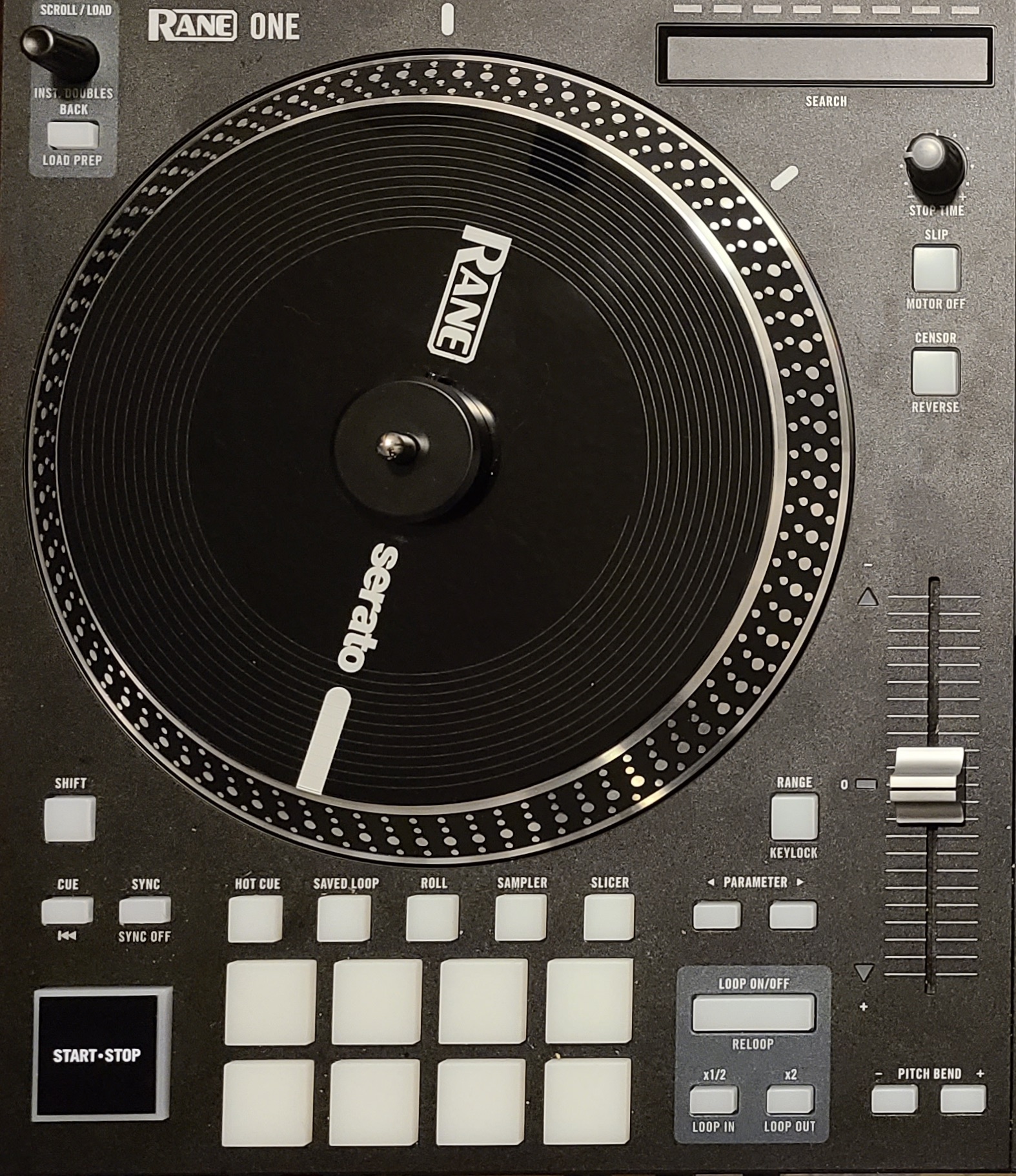
This isn’t so much of an improvement, but more of a request. Since the Rane Twelves were released, a vocal subsection of DJs have been wishing for a smaller, lighter version of the Twelves with more controls available. The player section of the Rane ONE is pretty much the perfect design.
Even the mixer section would make a great mini-mixer unit with a few tweaks. It’s been a long time since we’ve seen a thin mixer in the vein of the old Vestax PMC 06 Pro or the Ecler Nuo 2.0.
Final verdict: Is this the Rane controller we’ve been waiting all these years for?
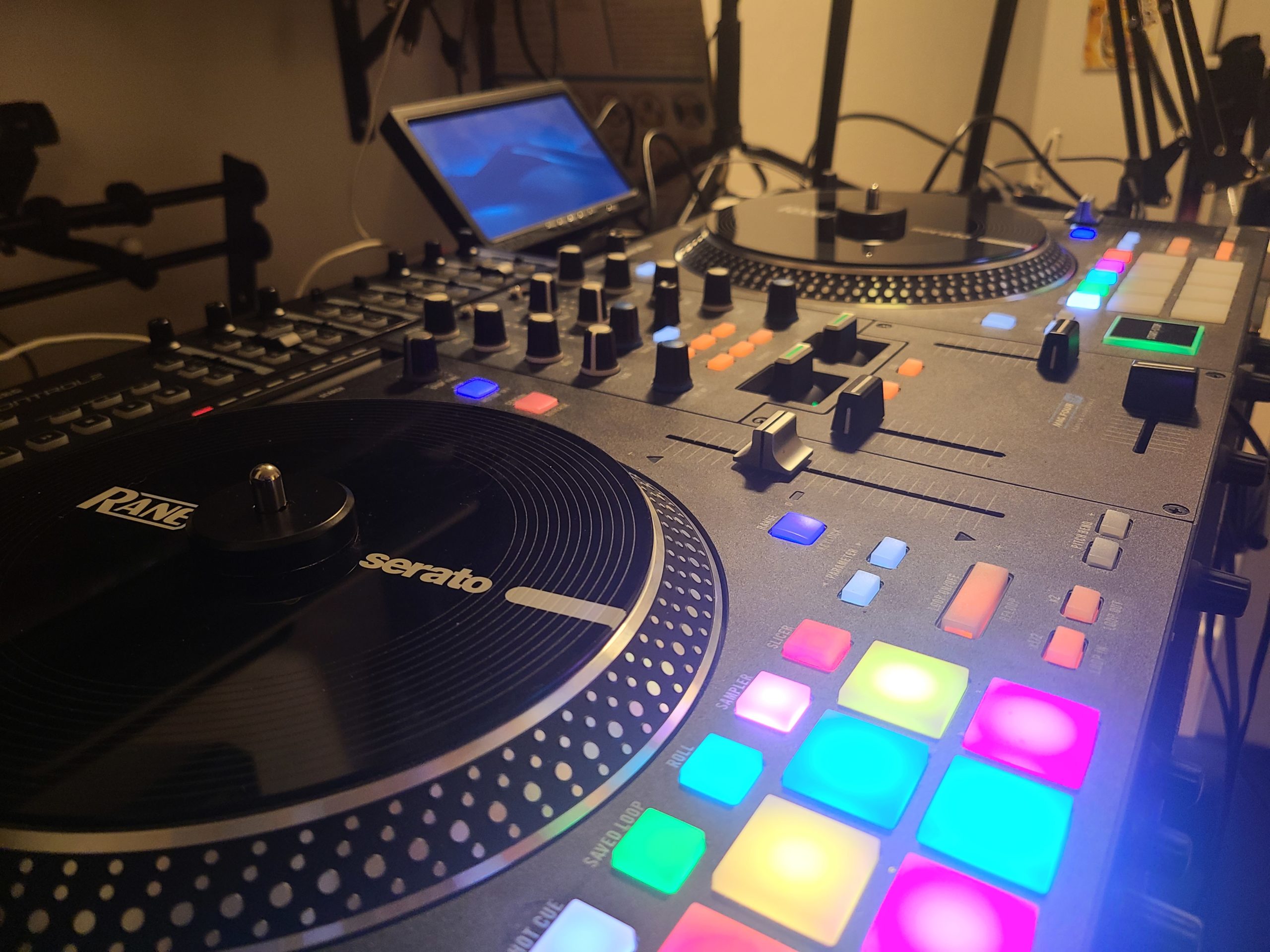
I’ve been a fan of Rane gear for almost 20 years now, and here’s the thing I’ve learned about it: the gear’s biggest selling point has never been their featureset or their design. Yes, a lot of their gear is very usable and chock full of innovations – but they never quite nailed the intuitive workflow of a company like Pioneer. There has always been some head-scratching interface or convoluted workflow, especially once they went digital. The 57 had a near-incomprehensible effects control scheme; the 62 was one of the more intimidating mixers to play on and buried some important features in its cryptic controls; the problems with the Seventy-Two effects controls is well-documented. What Rane excels at has always been the next-level, one-two combo of build and sound quality. That, along with the buttery smooth scratch faders, cemented the Rane legacy for decades.
“Entry level controller”
This is Rane’s stab at an “entry level” controller. I realize that $1,500USD isn’t entry level pricing, but the Rane ONE is anything but an entry level controller. This is a fully-featured, professional controller with some of the best sound quality on the market. It also just so happens to be extremely fun to play on and is the most affordable way to experience the new Rane ecosystem. I think instead of calling it “entry level,” a more appropriate term would be a “gateway controller.”
Going for familiarity
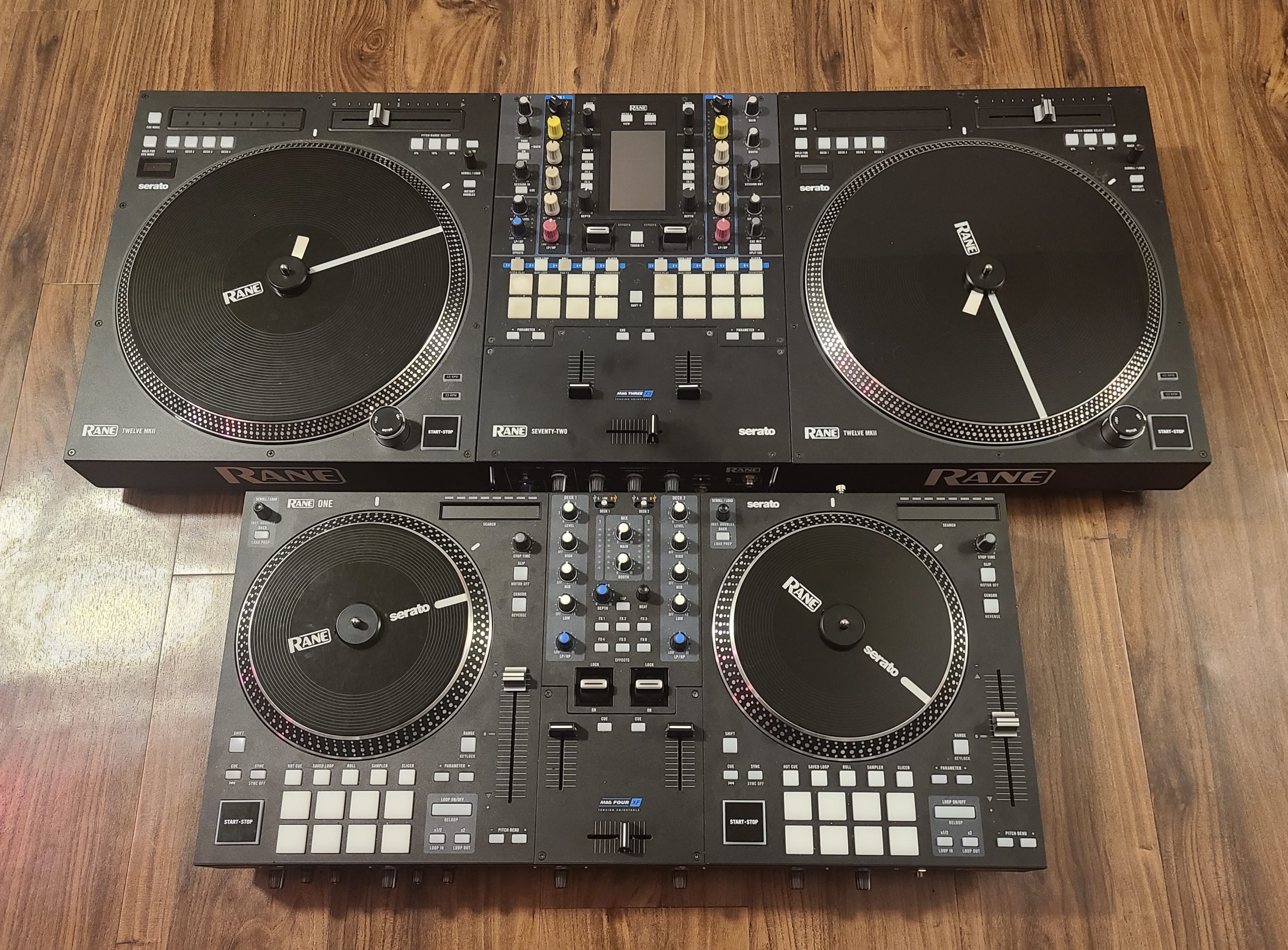
The Rane ONE really doesn’t have a lot of surprises to it (other than its entire existence being surprise). It very much follows a fairly standard controller layout with some cues taken from their mixers and the Twelves. The whole thing resembles a modern Rane setup, shrunk down, and glued together.
Who is it for?
Ultimately, this controller isn’t for everyone. Those looking for a feature-to-price ratio will likely not entertain the Rane ONE. Likewise, those uninterested in spinning platters will also probably take a pass. It also doesn’t offer too many innovative performance features outside of Scratch Bank and the spinning platters. Being only 2-channel will definitely be a turnoff for many. The pricing is also higher than average – costing more than a DDJ-1000SRT.
So, who is this for? It hits quite a few target audiences:
- For one, obviously, fans of Rane gear.
- Mobile DJs who want the feel of turntables or Twelves at their gigs at a significantly reduced size and weight footprint.
- Those looking to try out the new Rane gear, but balk at the premium pricing.
- Fans of spinning platters, professional build and sound quality, scratch capability (or all of the above) will love this controller. Rane has always gravitated towards the hip -hop, open format, and scratch/battle DJs of the world, and this product is no different.
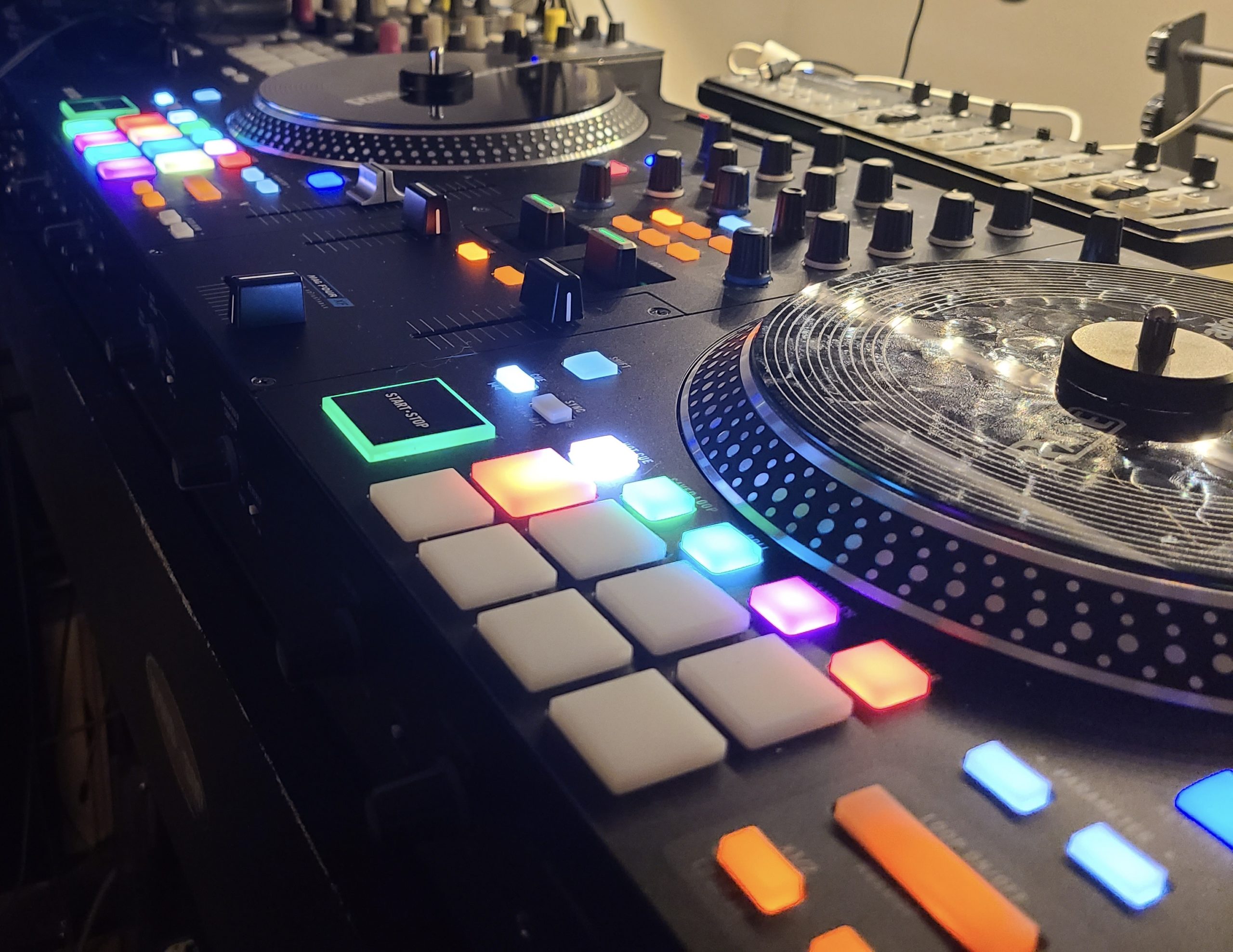
What makes it great
With Rane ONE, you get an incredibly solid, well-built, functional, and great-sounding controller. Yes, it’s only two channels; yes, the mixer section has a little more in common with the Numark Scratch than the Rane Seventy; yes, it really doesn’t offer too many features that other controllers don’t. But everything just oozes a superior level of quality that you don’t see in a lot of other pro gear – let alone controllers. With the Rane ONE, you’re really getting the intangibles more than the innovations. It’s a controller that turns the build and sound quality up to 11, and most importantly, it feels like playing on a Rane setup.
And if you haven’t had that experience, this might be the ONE piece of gear to get you into it.
The Rane ONE is out today for $1,499 USD, $1499.99 EU, and $1299,99 UK. Get a preorder in the DJTT store here.





